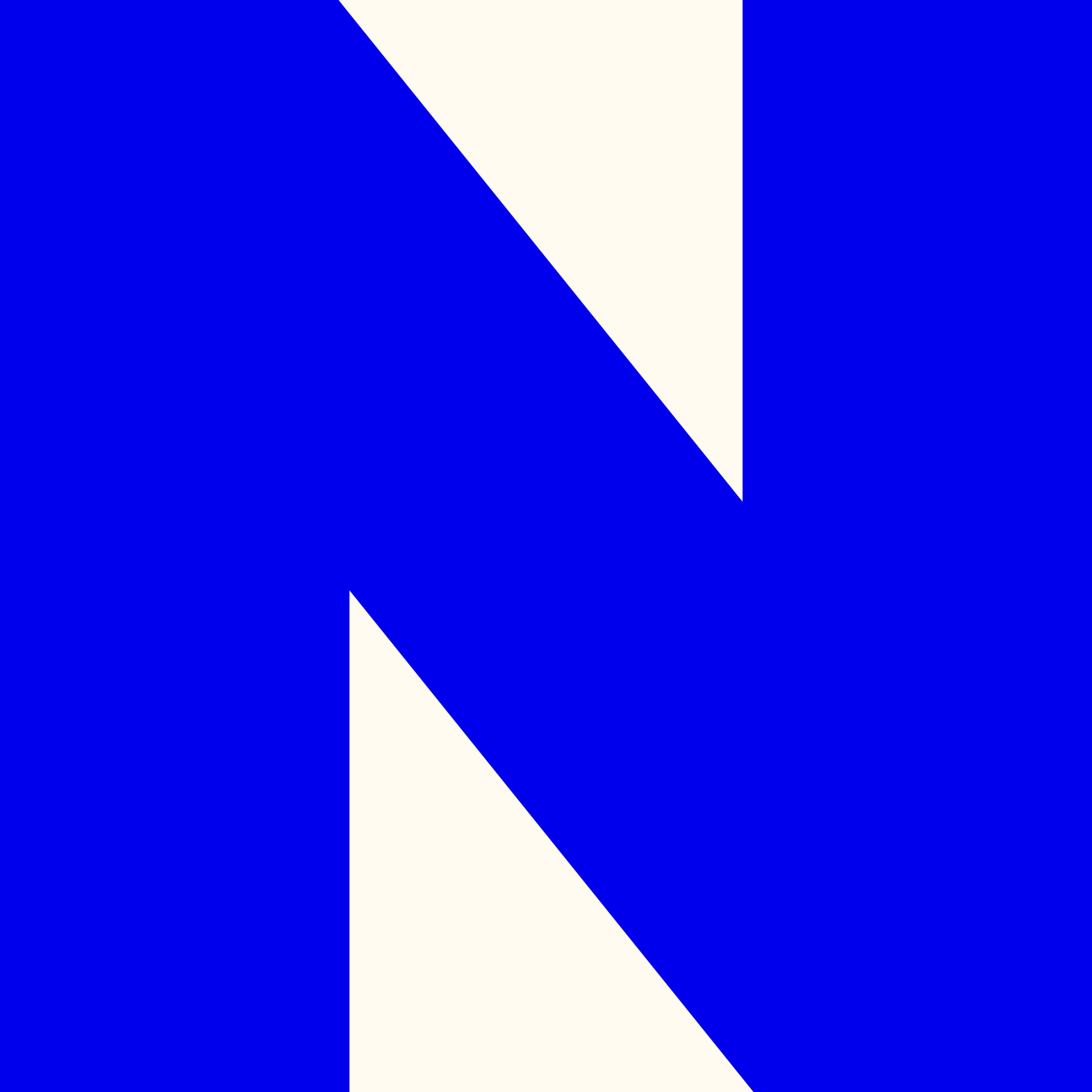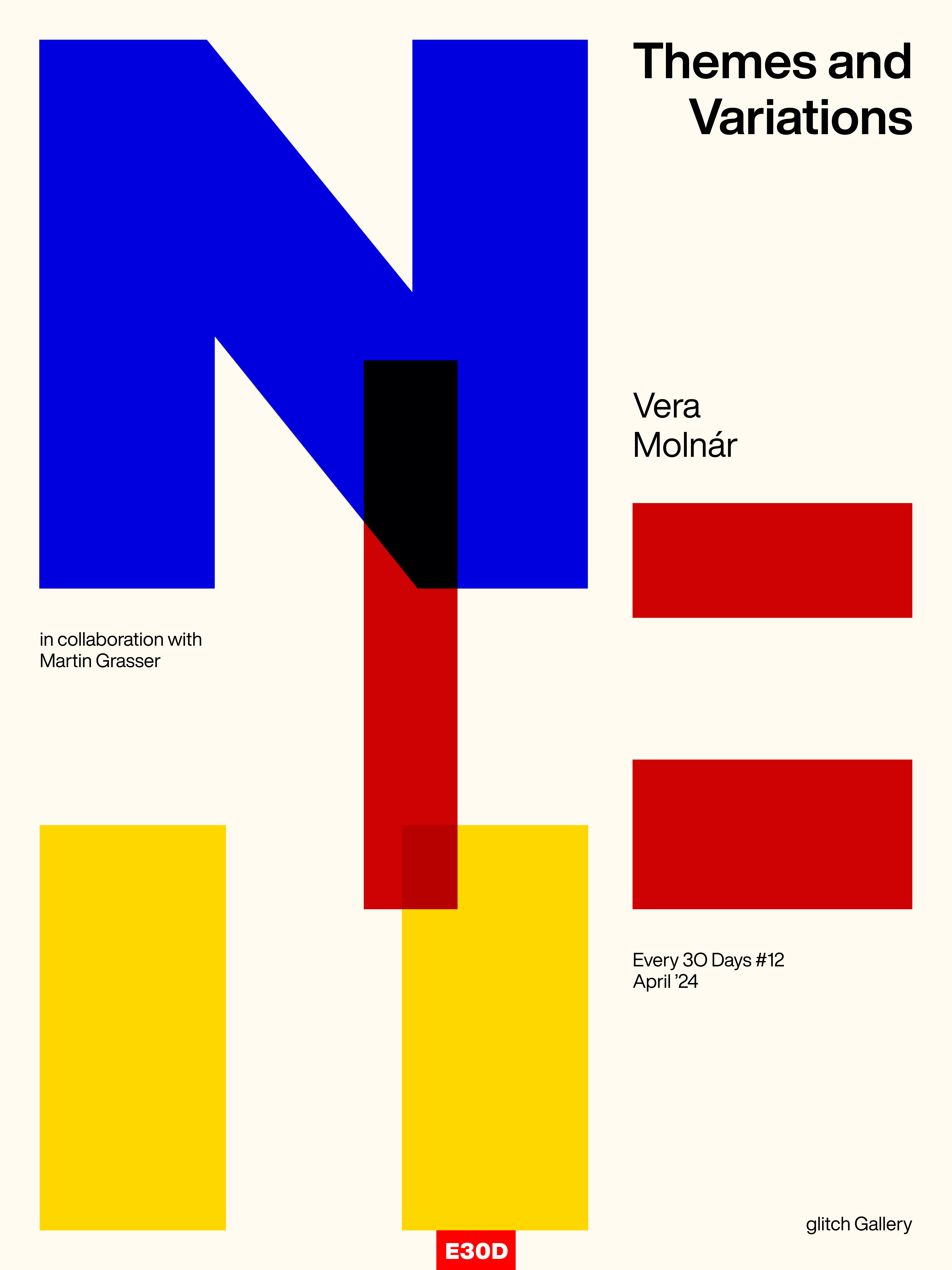In 2023, Hungarian-born Vera Molnár collaborated with Martin Grasser to release “Themes and Variations” – a timely celebration of belated recognition. It would be Molnár’s first foray into blockchain-based generative art.
Molnár’s journey began in the 1950’s, when she began working with generative processes and rule-based systems. Over the next eight decades, Molnár would find recognition in the art world. Yet, it was the resurgence of interest in generative art sparked by the 2021 enthusiasm of unique digital objects that led to a broader recognition of her achievements. Coincidentally or not, in 2022, the 98-year-old Molnár was invited to the 59th International Art Exhibition La Biennale di Venezia.
To date, the storytelling and cultural commentary of glitch Gallery mostly focused on writing a history of crypto art in the present. To conclude the twelve months of “Every 30 Days” series – a fragmentary history of crypto art in the present, without any pretense of completion or canonicity – today we pay homage to the history and aesthetics of a most remarkable pioneer of digital art.
The Dawn of Computer Art
After arriving in Paris in 1947 with her partner, Molnár met pre-war avant-garde artists and pioneers of early abstract art, including Kazimir Malevich, Wassily Kandinsky and László Moholy-Nagy. Around 1960, she co-founded the Groupe de Recherche d’Art Visuel (GRAV), which notably included François Morellet, a key figure in the development of conceptual and abstract art after 1945.
In her early compositions, Molnár extended the trajectory of early 20th-century abstraction through the medium of automation – first analog, then digital. This extension is evident in her focus on the grid, the cornerstone of painterly abstraction, as well as her tributes to the pioneers of abstract art in her pre-digital works.
Nevertheless, early on Molnár challenged the “pure” language of abstraction by altering and dispersing the grid. The pivotal method for opening up the trajectory of abstraction to a new direction was the utilization of code-based randomness—arguably the successor to the notion of painterly abstraction as a process of reduction.
.jpg)
In 1968, Molnár first gained access to a computer at Sorbonne University.
However, her earliest experiments had to rely on a trial-and-error approach since the computer did not allow for adjustments in real time. As Grant D. Taylor describes, the technical capacities were strictly limited: “Instructions were punched into cards that were fed into the mainframe, and output instructions were sent to the plotter.” 1
Around 1974, Molnár started working with a display that allowed her to adjust parameters and variables during the process.
Molnár typically starts with basic geometric shapes and then alters, deforms and deconstructs them using an algorithm that injects random patterns. Despite the inherently deterministic nature of code, which confines randomness to a pseudo-random number generation, the complexity of Molnar’s algorithms enabled the generation of unimagined forms.
%20Ordres,%201974.jpg)
Seriality is a natural complement to automation. Presenting these alterations in a series allowed Molnár to explore “what kind of formal modification challenges the change in the perception of my picture.”2 Moreover, the series underscored the systematic aspect of her work, demonstrating that the artwork-as-system unfolds not through an isolated form but through variations and permutations across various themes.
The logic of the series brings to light the hidden potential of repetition – not the repetition of the identical, but the repetition of difference; that is, the emergence of the unpredictable from variations of the same.
The Intuition Machine
In an intriguing, untitled text from 1975, Molnár detailed her initial approach to generative art, discussing the perceived contradiction between intuition and cognition—a dichotomy present in numerous aesthetic concepts (ranging from content and form to the Apollonian and Dionysian). According to Molnár: “Art at its inception is essentially intuitive, it is in its elaboration that intuition needs control and aid by cognition.”3
For Molnár, the creative process began with an intuition, an element elusive to cognitive explanation. However, she contends that the comprehensive exploration and development of this initial intuition depend on cognition, which automation and systematization can augment.
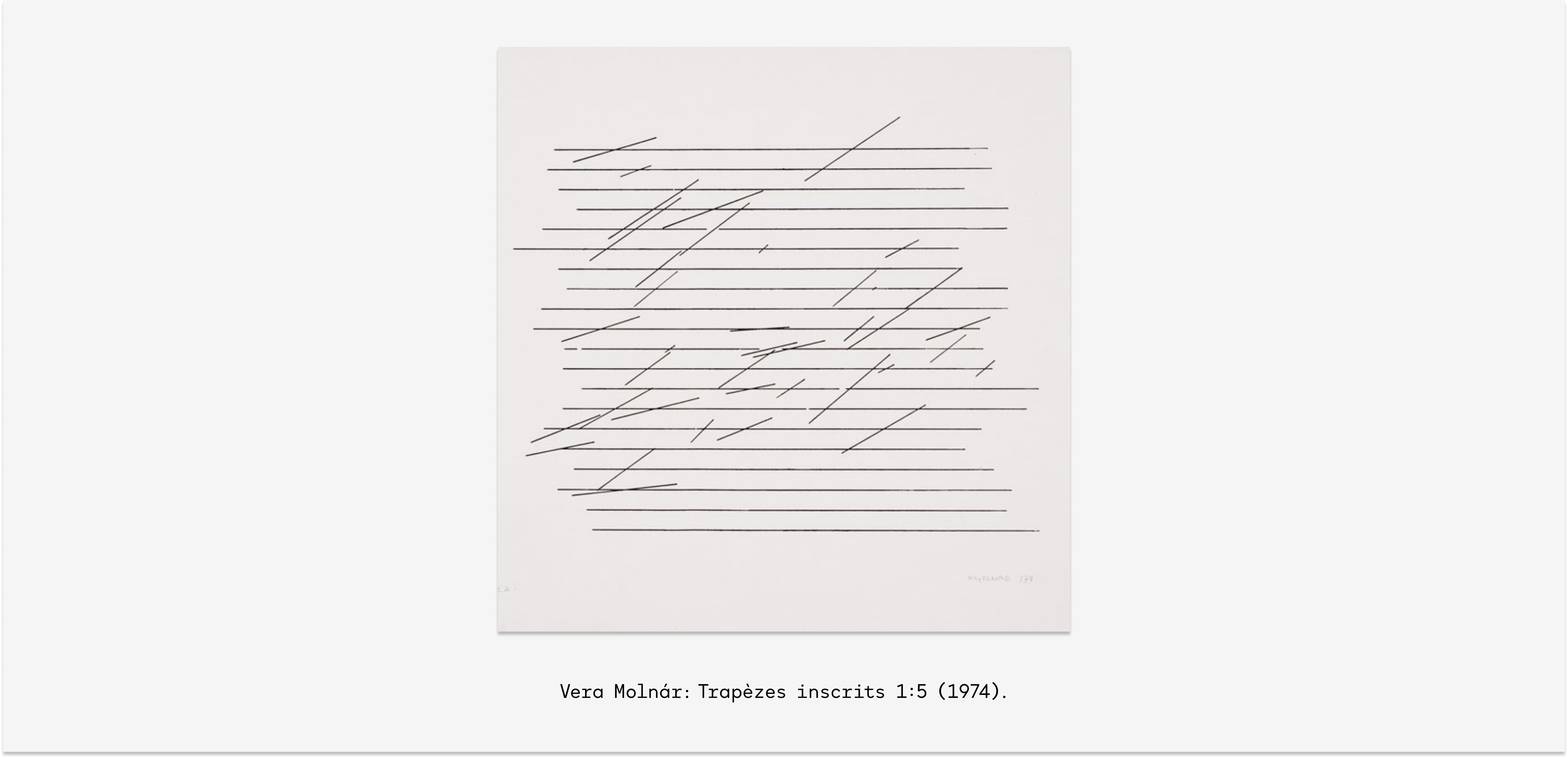
Thus, in Molnár’s view, intuition and automation are not at odds; rather, they complement each other. This perspective mirrors Molnár’s characterization of her work as a “machine imaginaire.” Although her algorithms’ outcomes are theoretically predictable, their complexity renders it impossible to fully envisage or visualize the potential outputs, effectively transforming the machine into an extension of the human imagination. The essence of Molnár’s “machine imaginaire” lies in its ability to reveal aspects latent in the artist’s initial intuition but beyond their own imagination.
The notion of the “machine imaginaire” leads Molnár’s to view the computer as a means to an end rather than the focus of her art: “I don’t care about computers, but the computer is like a slave in making my dreams a reality.”4 In fact, Molnár emphasized that her employment of computers is “only a systematization of the traditional-classic approach” to composition rather than its replacement.5
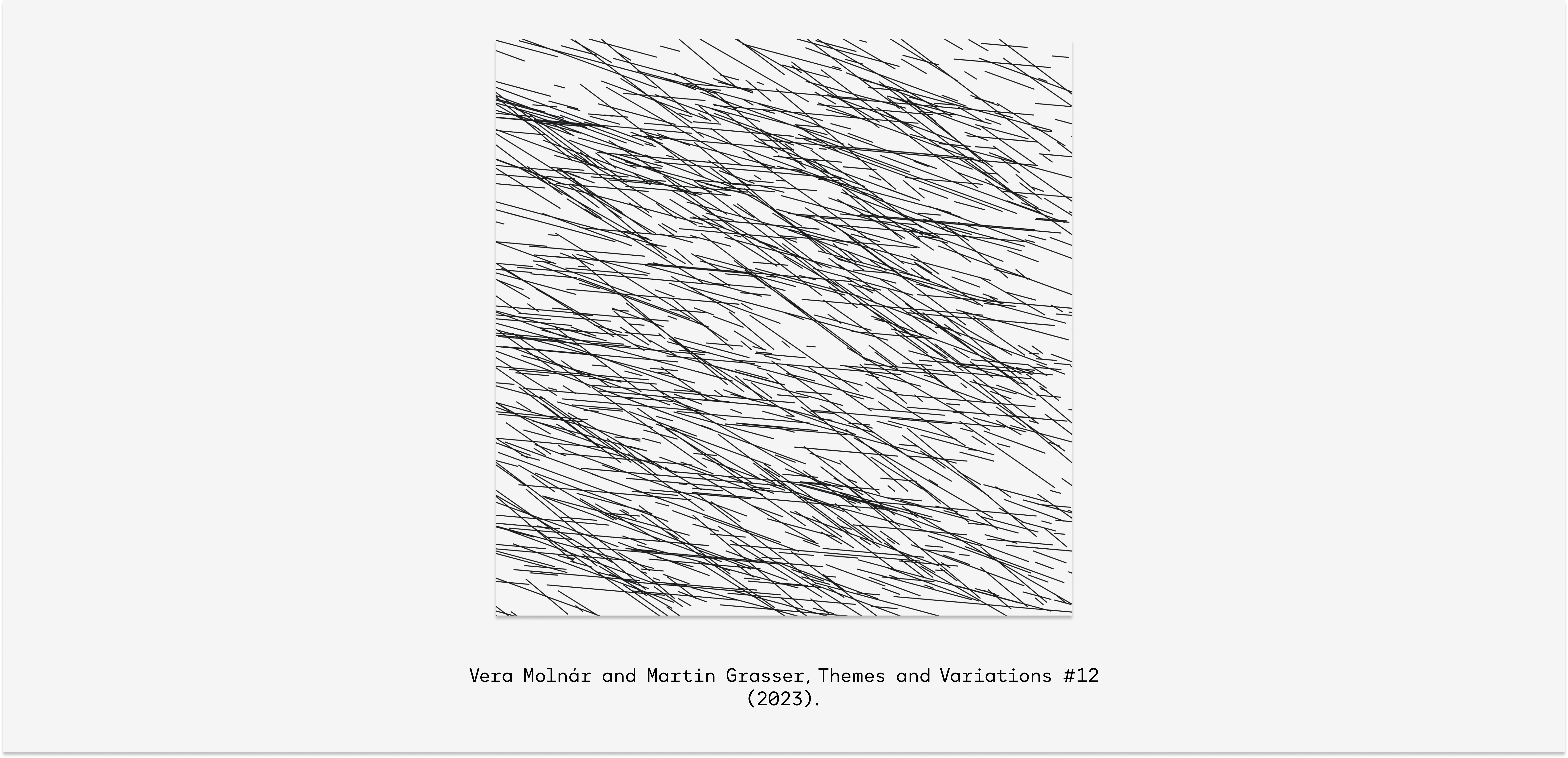
Yet, in the early days of the computer era, Molnár’s use of the device in her art encountered skepticism. The rise of abstraction in early 20th-century art had already sparked debates about “dehumanization” among cultural conservatives, and similar doubts shadowed Molnár’s initial forays into computer art. While abstraction moved art away from depending on the external world for meaning, employing computers to create abstract compositions decentred the artist’s subjectivity as the sole source of meaning. Now, artists and computers entered into a dialogue that reconfigured the dynamics of the creative process.
Variations on a Theme
The eight decades of Molnár’s art production demonstrate remarkable loyalty to the broadly minimalist aesthetic of early generative art, coupled with a relentless interest in experimentation. One such experiment concerns Molnár’s interest in letterforms. The use of the letters “M” and “N” appears in Molnár’s work as an alternative to the elementary geometric shapes common to the visual language of painterly abstraction.
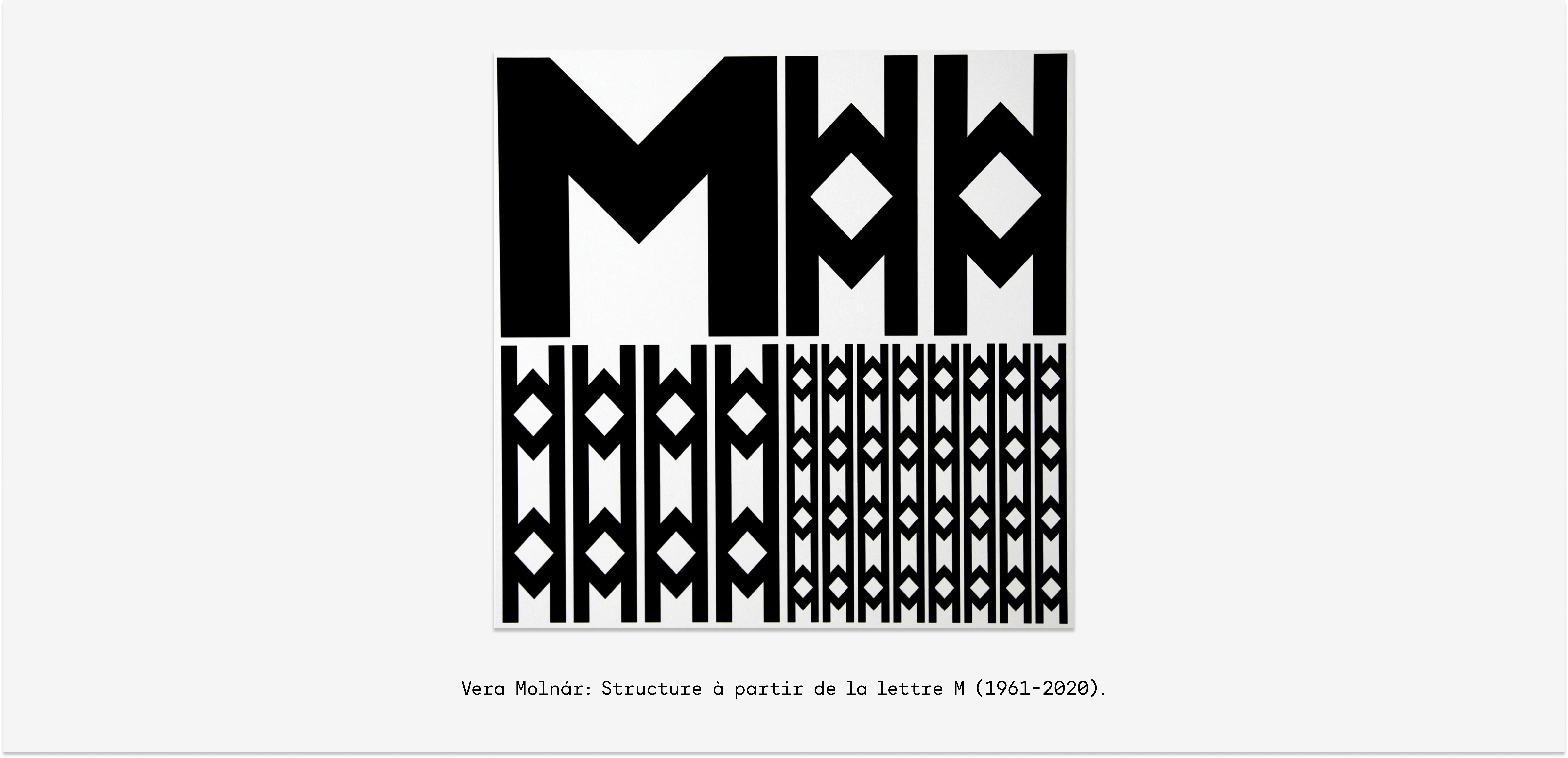
Generally, letters played no crucial role in the development of abstraction in painting (Jasper Johns’s work is a rare exception). As the most elementary components of the signifier, letters are themselves devoid of meaning; to mean something, letters generally need to be combined with other letters to form a signifying unit (with the obvious example of single letter words). However, letters are immediately recognizable as having semantic value and, as such, they lack the purity of abstract forms, such as the square. Otherwise put, letters occupy the indeterminate space between an abstract form and a signifier – immediately recognizable as a grapheme yet too abstract to possess concrete meaning.
.jpg)
This may explain their lack of appeal to the majority of abstract painters, who tried to find a self-sufficient visual language. For Molnár, however, one might speculate that the letterform was a less overdetermined form than the basic geometric shapes originating in painterly abstraction.
She hints at this perspective in an interview, where she explains the similarity and differences between the form of the letters “M” and “N” and the square: “The letter ‘M’ is a wonderful thing because it’s a square, only it has a direction, it is vectorised in some way. From the moment that it’s no longer a square but a letter ‘M’, there are already four positions and that really enriches the situation. So, putting two and two together, so to speak, from the letter ‘M’, I went on to the letter ‘N’, which can also fit inside a square, or not.”6
,%202016.jpg)
When examining Molnár’s work exploring the letterform, it becomes apparent that her procedure resembles the injection of random, dissonant patterns onto the grid. In works like the aptly titled “N En Désordre (Gris)” [N in Disorder (Grey)], the artist presents variations on the basic form of the letter N.
The compression and extension of the letter are pushed to an extreme where the form loses its semantic content and becomes a pure bar. All 56 variations of the letter are arranged in lines of similar lengths, transforming the entire image into a square that oscillates—as a form of semiotic play— between pure abstract forms and grapheme.
Thus, Molnár’s 2023 “Themes and Variations,” created in collaboration with Martin Grasser, builds upon and extends these earlier letter-based works. The series, released through Sotheby’s and minted on the Ethereum blockchain, began with simple sketches, presenting the letters N, F, and T within squares of equal sizes. Clearly, the selection of these letters references the acronym for non-fungible tokens, which were standardized through the ERC-721 format and facilitated the first wave of mainstream adoption of digital objects in 2021.
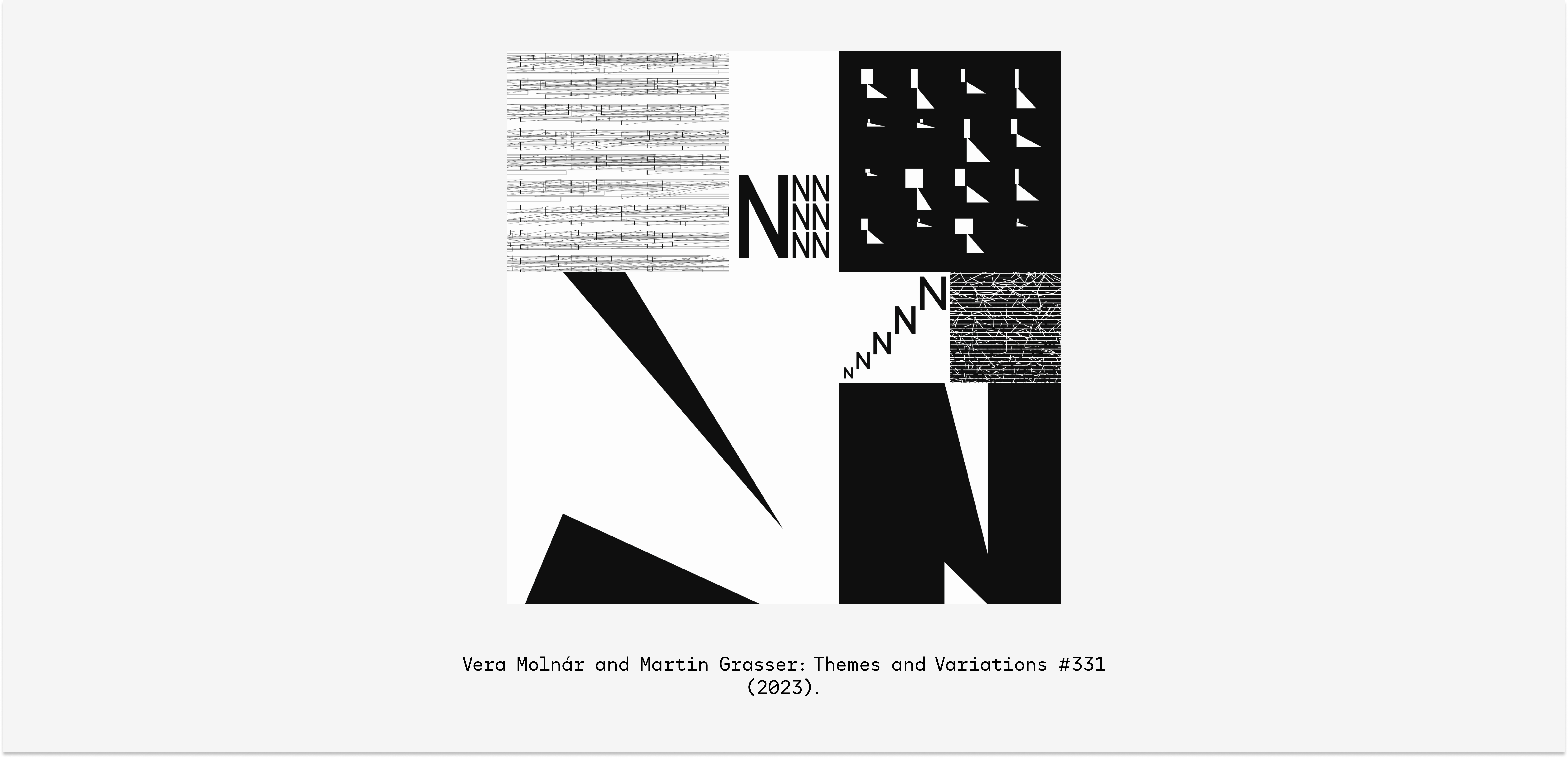
Molnár’s initial sketches evolved into black-and-white artworks, where the familiar forms of letters morphed into abstract compositions. The analog works were then incorporated into an algorithm that parameterized Molnár’s initial design decisions. When asked about their collaboration and the choice for the letterform design, Grasser notes:
“I can’t exactly speak for Vera but I believe she worked with letters because they are abstract shapes that are also familiar. There is a nice tension there, when you start with a capital ‘C’ as almost a circle as opposed to a shape that bears the responsibility of carrying the sound associated with ‘C’ either by itself or strung together with other letters to form a word.
The abstractions having meaning, in particular, N, F, T are important especially in that order. I think for Vera, it struck her that she was making this work for close to eight decades, and these three letters had somehow magically appeared next to her body of work. For me, I cannot quite explain it - but I have the same fascination and love for letters, typography, words, sentences and paragraphs of text. In one instance they are pure form, and shape, but as a group, we have imbued these shapes with meaning. Sometimes we can separate these two things; form and content, plot and story, etc… and then it becomes interesting to re-see or to see the shapes in a new way.” 7
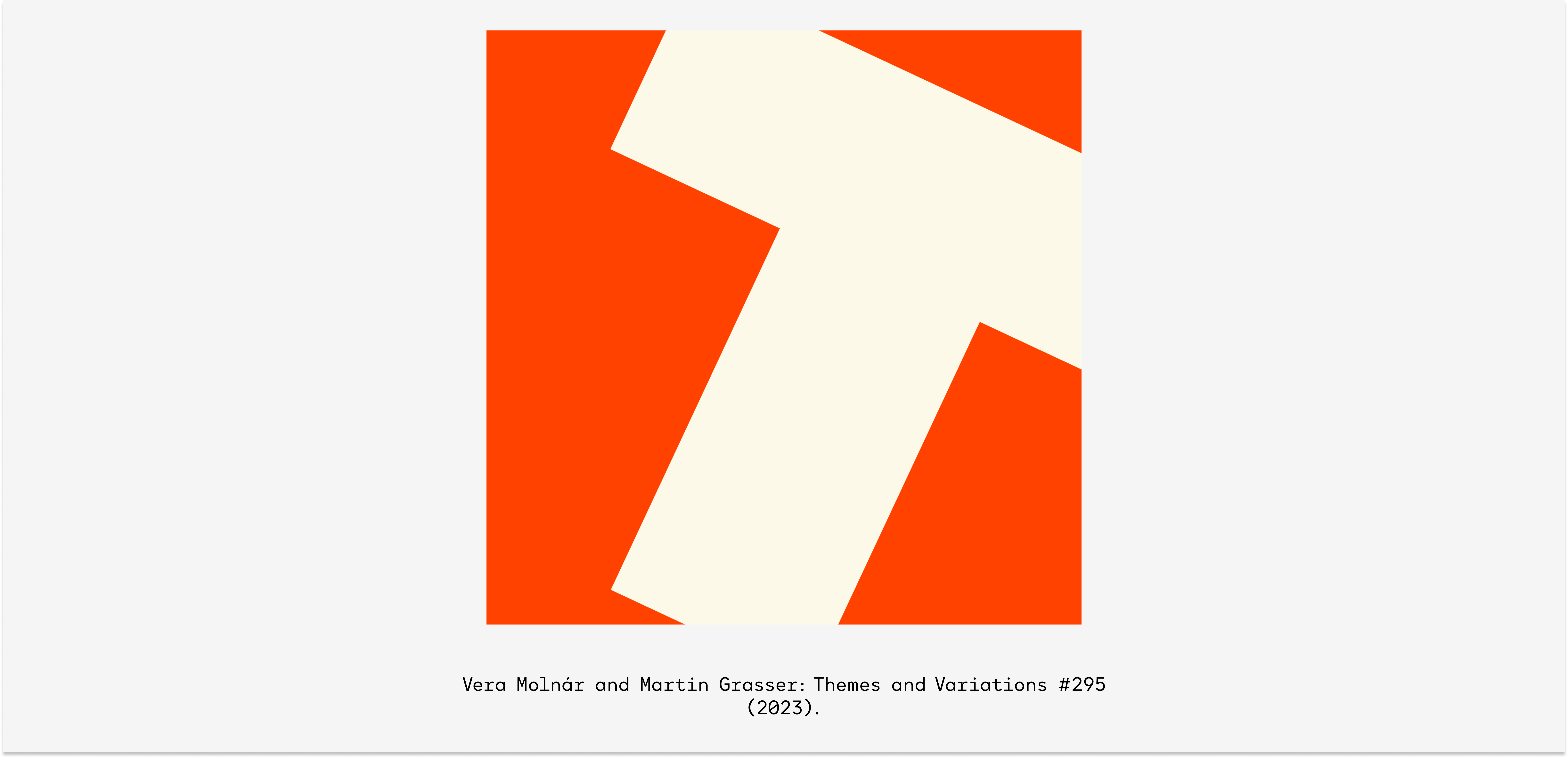
Through their collaboration, Grasser and Molnár showcase 500 variations on these three letter forms. If works such as “N En Désordre (Gris)” illustrated the transition from grapheme to abstract form, “Themes and Variations” reveal a comparable interest, yet the extensive algorithm permits a wider range of formal variation. The output space includes everything from a single, prominent letter occupying the square to neatly or disorderly arranged small letters, and to entirely random forms that have discarded all resemblance to the grapheme.
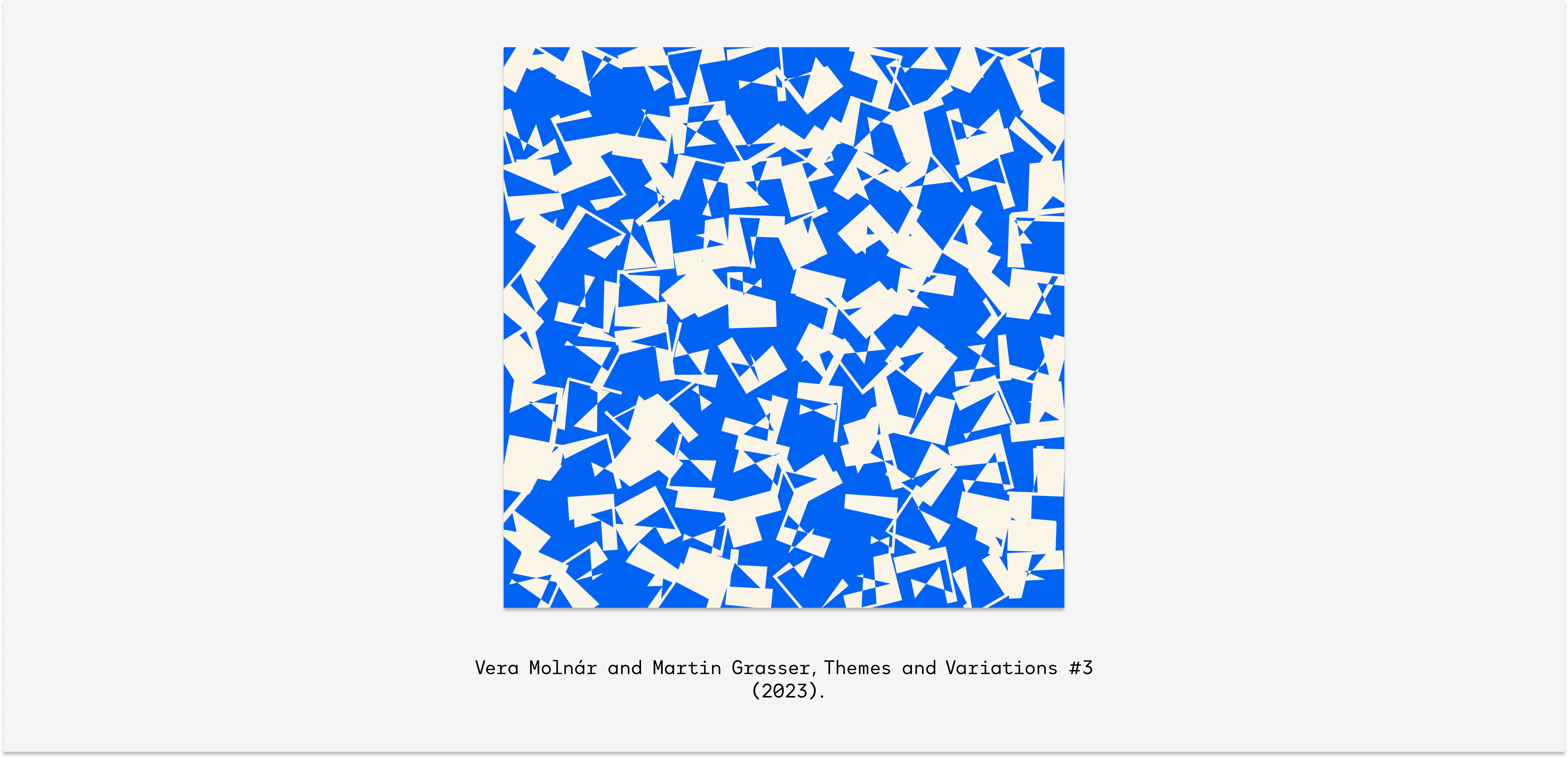
Each output presents variations of a single letter; none combines them to a signifier. This month’s exhibition object is therefore a triptych of three distinct works that together spell out the signifier “NFT,” which the initial letter selection alludes to. Meaning is not given in the series; it is generated through the combinatory logic of randomization, and scattered across the spectrum from order to chaos.
Similarly, the series as a whole can be interpreted as hinting at the emergence of artistic meaning from the “conversation” between human and machine, order and chaos, randomness and determinacy. From the early experiments with grids in the 1950s to the 2023 variations on the letterform, Molnár pursued this “conversation” through the exploration of automation and abstraction. As the artist herself put it seven years before her passing in 2023, just months after the debut of “Themes and Variations”: “I have no regrets. My life is squares, triangles, lines.”8
This writing concludes glitch Gallery’s genesis collection: Every 30 Days. The curators wish to extend their deepest gratitude for the positive reception of this exhibition series. As such, we’re excited to celebrate what’s next for glitch - please see our Twitter thread for a few special announcements and opportunities.
-
Grant D. Taylor, “JOB FROM MOLNAR”: Pioneering Computer-Generated Prints,” in Art in Print, January/February Issue (2019), p. 13. ↩
-
Vera Molnár, “Untitled,” (1975). In fact, early Molnár was a proponent of the idea that the underlying principles of aesthetic experience could be discovered via empirical research and perception psychology. See Grant D. Taylor, When the Machine Made Art: The Troubled History of Computer Art (New York: Bloomsbury, 2014), p. 126 ↩
-
Molnár, “Untitled,” n. p. ↩
-
“Vera Molnar in conversation with Hans Ulrich Obrist,” in Bookmarks: Revisiting Hungarian Art of the 1960s and 1970s, eds. Hans Ulrich Obrist and András Szánto (Koenig Books, 2018), p. 77 ↩
-
Vera Molnar, “Untitled,” n.p. ↩
-
“Vera Molnar in conversation with Hans Ulrich Obrist,” p. 84. ↩
-
Private message to the author, March 28th, 2024. ↩
-
From the Vera Molnár interview by Studio International (2017): https://vimeo.com/273642211 ↩
